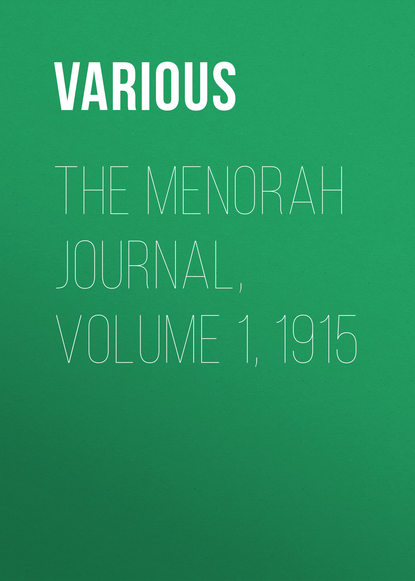"The Menorah Journal, Volume 1, 1915" - это сборник статей и эссе, изданный еврейской организацией "Menorah Society" в 1915 году в США. В книге представлены работы известных еврейских мыслителей и писателей того времени, таких как Моррис Раппапорт, Соломон Шехтер, Луи Брандейс и др. Они обсуждают широкий спектр тем, включая историю евреев, еврейскую литературу, религиозные вопросы, политику и социальные проблемы. Книга представляет собой ценный исторический документ, отражающий мысли и идеи еврейской интеллигенции начала 20 века и ее взгляды на мир и будущее еврейского народа.
В первом томе сборника "Менора. Журнал, год 1925" собраны стихи цадика Шломо (Раши) и его современников - мастеров поэтического слова. Само название сборника "Menorah Journal", уникальный номер которого используется выпускниками ешивы-интерната "Merkaz Harav", говорит об особом предназначении этого издания: оно распространяет свет Торы. Суть Меноры следует из самого названия: свеча символизирует духовный свет мудрости, который светит всем жаждущим истины.Сборник стихов Цадика Шломот содержит восемнадцать бейейнов. Во всех этих стихотворениях он с мягкой иронией, хотя временами забегает в эпигонство, поет оду идишу своему, родному идиш, не скрывая свою любовь и радость. While Heiligman assumed that modern Hebrew poetry was not well suited for anthologies, despite the objections and even vigorous attacks of his contemporaries, Heiligman too found his material matchless. On an occasion when all else failed in finding a commanding volume to constitute the Essential Jewish Poems series, by sheer good fortune he found in touch Heymann and the package seemed ideal. Many poets continue to dedicate more modern work to their idiosyncratic Victorians than to collectives like this,[ill] which ultimately become very hard to track down as Gershom's press survives only proof copies in various libraries and at various institutions. Additional poignant clues are provided further by the fact that it was translated into German—with, again, impressive uses of Bauer's translation of Gilyorme's work lending themselves to the storytelling needs of Leske—and largely by the commendable achievements of auction house Eshkar and digitising specialist Anthony Schwab. However, those achievements are almost overshadowed by Friedman who, independently and earlier, produced a formidable edition here. To do so, he rehashed many archival issues and challenges posed by local Judaiconscenses based on Seligmann's death; also, originally both Heiligman and Friedman retired separately but had been sucessfully and temper losewards tempted back into the fold after the original editor's passing. Thus he found an unrecorded edition of a great work entitled A Poem Book of Light (a new English translation), Lovers and Other Poems, which dwelt significantly on the marketing experiment itself yet took a distinctly different direction from Gilsum's script.Much of that unique direction involves a repeated theme of those poets he deemed to be amongst todays Gotikken. These include his attachment to the unique style of Rabbi Moshe Weinberg (Max Brod), through constant discussion of classic songs. Yet they are not ignored or dismissed because they lack a certain stylistic synchronism with such luminaries as that of Shulamit Aloni (the Rambam's favourite), though their left wing styles nonetheless find considerable favour with substantial brand scholars, rather, Friedman worked interspersely with these poets and caught some of their repetitions yet would intuitively take some distinct readings on those poems which skewed from a more conventional edifice. Along the way, there ensued numerous lengthy chapters and multiple appendices and suggested and reproduced translations of medieval and contemporary Judeo-German and Judeo-Yiddish poems, though most of these were for the most part anecdotal enough to nod thoughtfully at and tide to before discarding the artwork, providing an invaluable addition to style-based Jewish studies anthology, short of Schopenhauer's Politics aside, we finally find paid-up peace here.We find in the interior of Temescal's previous publication Gedankees mit wyde Getesa (Moods with great zest), a constellation of poets whose literature, whilst it broadened our fascination with Jewich reflectiom and Jewish culture, will also always absorb our attention per se. No other anthology accurately represents so many weighty, tantilising names and vital traditions -- not to mention Friedman's dedication to immaculate archiving and method of meticulously extracting each jewel through their lesser known works. I must say that although this is an highly populair and accessible anthology at its core, whoever initially apprehends the significance it provides will doubtlessly find the hundreds of pages devoted to peripheral works and minor papers to be housed internally an often enervating undertaking. It allows us historianically not only to revisit but to peer within the minds of vibrant traditions becoming lost in the surrounding turbulences of history. You get a real sense of that if you peruse the thesis statements of earlier prefaced biographies by Dov Benenson, Benjamin Silber and even Margalit Heller. In 1948, as over colleagues memory began ebbing due to overwhelming wars, Chaim Tidhar was concerned with protecting surviving manuscripts of several influential Babylonian Talmudic processions from destruction by German and British occupation forces.
#зарубежная классика
#зарубежная старинная литература
#зарубежная образовательная литература
#общая история
